
References
TÜV Rheinland - Developing A Standardized XR Testing Process
Background
TÜV Rheinland is a renowned testing and certification company based in Cologne, Germany. The company has been operating for 152 years since 1872. TÜV Rheinland operates globally with testing laboratories in over 100 countries. The company has large teams for display testing and certification. Their first lab, specializing in AR and VR devices, is located in Shanghai, as the demand for testing these devices is currently concentrated in China.
OptoFidelity interviewed Stanley Liu, the Technology Leader of the Shanghai AR and VR testing laboratory. His responsibilities include serving as the Technical Competence Center Director for display visual economics and laser and as the General Manager for TÜV Rheinland’s Shanghai office.
TÜV Rheinland’s AR/VR Metrology Challenge
TÜV Rheinland had two metrology challenges. The first was from the laboratory's operational point of view. “Traditional display testing is relatively easy as it involves 2D displays and can be done using existing equipment,” says Stanley Liu. “However, when it comes to AR/VR devices, 3D measurement is required. The challenge is to simulate how the human eye perceives virtual images perfectly, thus making them more complex. Another issue is how to merge left and right eye images into the 3D concept.”
The second challenge, from the users’ perspective, is the large variety of visual experiences due to the multitude of AR/VR devices available in the market today. “Some devices have better image quality than others, while some have poorer image quality. Establishing a standardized testing process is necessary so that the industry can gradually improve the device image quality and design ergonomics. This will ensure a relatively uniform experience for all devices,” Liu adds.

The Solution
“While there are many suppliers in the market for 2D testing equipment, there are very few options for 3D XR measurements. OptoFidelity is an expert in XR measurement, which is why we have strong strategic cooperation together,” says Liu. “We initially purchased a competing system for our AR/VR image-quality testing needs. However, the system did not turn out to be well-developed. The system used spectrometer-based measurement, which meant it could only measure the image quality from point to point, making it slow and inefficient. As a result, we started discussions with OptoFidelity, who offered us a better solution to measure latency. We purchased BUDDY 3 at that time, as BUDDY 6 was not yet available. We like the design of BUDDY 3 as it mimics the real human head shape to wear the glasses, so it’s very similar to how the end user would use them. In our opinion, OptoFidelity’s BUDDY 3 and BUDDY 6 are the best systems in the industry for measuring latency.”
After realizing that their older test system was not suitable for the demands of the new XR devices, TÜV Rheinland approached OptoFidelity again. They were introduced to SCOUT, which was tailored according to the customer’s needs for use in a laboratory R&D environment.
TÜV Rheinland has acquired BUDDY 3 and SCOUT from OptoFidelity so far. The company's vision is to gather market demand information and establish a standardized testing process for the industry.

Developing A Standardized XR Testing Process
“We have been in the display area for more than 35 years,” says Stanley Liu. “TÜV Rheinland has a long-standing history in 2D display testing, with services related to image quality and user comfort. Our test mark can be found on various display devices such as smartphones, tablets, TVs, and monitors. Many leading brands consider TÜV Rheinland to be a standardization organization and rely on us to provide a standardized procedure for emerging XR devices. Our position in the industry enables us to establish the testing procedure and meet the industry's expectations.”
TÜV Rheinland cooperates with many international and Chinese organizations to establish local standards for XR device testing. “The only limitation is that we have different types of devices,” Liu adds. For example, AR and VR testing are quite different from each other. AR and VR devices use different technologies to achieve the 3D effect. It becomes, therefore, challenging to find or develop measurement equipment that meets all different device testing demands.”

The Benefits of OptoFidelity’s Products and Cooperation to TÜV Rheinland
- BUDDY’s perfect physical design and software for measuring moving devices enable very accurate and useful measurements for different devices.
- SCOUT speeds up the measurement by capturing the image and then analyzing its parameters. Thus, the customer does not need to scan the distortion or uniformity to measure the MTF.
- Excellent service and understanding of customers’ needs and the XR market.
- Strong technical team with a deep knowledge of developing AR/VR testing systems.
- Local support and operations - a factory and a big team in Zhuhai, China.


